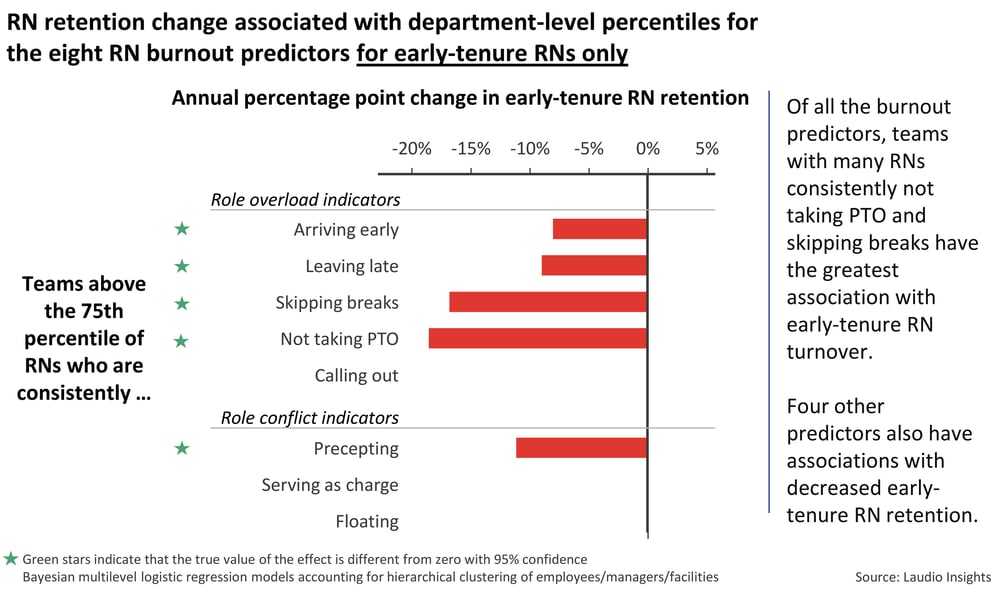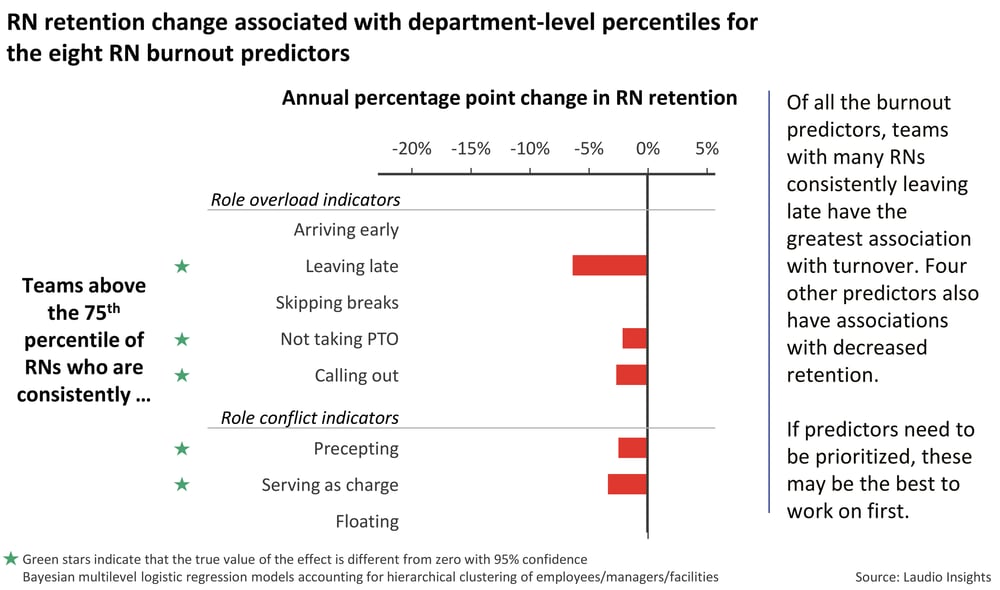
What the data says
Analysis of Laudio’s national workforce dataset (inclusive of 150+ hospitals and almost 95,000 nurses) identified eight key predictors of RN burnout (listed below). Additional analysis determined the nurse-level and department-level thresholds at which each of these eight metrics become predictors of elevated risk of burnout and turnover at the team level.
The eight burnout predictors serve as an “early warning system” for healthcare leaders, based on their operational nature, turnover predictive power, justification based on peer reviewed literature on burnout, and prevalence in executive and manager discussions.
The 8 RN burnout predictors:
|
Role overload indicators |
Role conflict indicators |
As shown in the chart above, teams where many Registered nurses (RNs) are consistently not taking paid time off (PTO) experience a 20% higher first-year RN turnover rate. Similarly, teams where many RNs are consistently skipping breaks, precepting, leaving late, and arriving early also experience higher early-tenure RN turnover rates. The data also shows burnout correlation around consistent precepting, leaving late, and arriving early. In other words, when early-tenure RNs join these teams and see existing team members under stress, they are much more likely to make a quick decision to leave.
The chart below shows a similar analysis of the turnover rates for all-tenure RNs. The associated turnover rate increase is less pronounced but still statistically significant. In particular, teams where many RNs are consistently not leaving late are associated with about 7.5% point higher overall turnover rates for RNs of all tenures (the top red bar in the chart below). Teams where many RNs are consistently not taking PTO, are calling out, precepting, and serving as charge also see elevated turnover levels.

The eight burnout predictors shown in the two charts are proposed as an “early warning system” for healthcare leaders. Laudio and AONL selected these eight predictors of burnout based on a combination of reasons, including peer-reviewed research on role overload and role conflict and the ability of most health systems to measure them.
While most data on nurse burnout today comes from self-reported surveys, these types of predictive, operational metrics can enable nurse leaders to actually get ahead of burnout, allowing targeted, strategic intervention in real time.
An Early Warning System for Nurse Burnout: Metrics and Strategies, a fall 2025 report co-written by American Organization for Nursing Leadership (AONL) and Laudio, includes more information on the metrics (their definitions, the statistical models used, and details of executive and manager strategies).
What it means
These findings point to clear, actionable priorities for leaders
-
- Managers and executives should prioritize reducing the incidents of RNs leaving late
-
-
-
- Teams with many RNs consistently leaving late experience higher turnover, especially among early-tenure nurses.
-
-
-
- Ensuring RNs take breaks and PTO consistently is also high-priority
-
-
-
- Skipped breaks and unused PTO indicate role overload, which occurs when nurses cannot complete work in time and are core components of burnout.
-
-
-
-
-
- These teams are potentially sending early-tenure nurses the message that working on their unit is unsustainable and undesirable from a healthy environment perspective.
-
-
-
- Executives should prioritize the departments with higher levels of early-tenure RNs
-
-
-
- Leaders should ensure managers understand how these patterns impact early-tenure (e.g., new graduate) retention, have the data needed to identify issues, and receive support in taking corrective action.
-
-
-
-
-
- As one manager said when interviewed about these topics, “skipping breaks and leaving late cannot be normalized.”
- As one manager said when interviewed about these topics, “skipping breaks and leaving late cannot be normalized.”
-
-
Implications for healthcare executives
-
- Build for visibility
-
-
-
- Executives can better surface these burnout indicators early by using technology to track them and simplify reporting.
-
-
-
-
-
- Combine data insights with conversations with frontline managers and team members (e.g., through leadership huddles and manager 1-1s) to help ensure leaders can spot and address early signs of strain before they intensify.
-
-
-
- Build for sustainability
-
-
-
- Reducing role strain requires rethinking job design to minimize unnecessary burdens and clarify responsibilities.
-
-
-
-
-
- Strategies such as creating dedicated charge nurse roles, expanding float pools, and adopting workload redistribution models can relieve pressure on core teams. However, these approaches work best within a culture that prioritizes well-being, balanced workloads, and role clarity.
-
-
Health system leaders face a pressing need to address burnout proactively. By using some of the metrics and leadership strategies discussed, nurse executives can create early warning indicators for burnout and intervene proactively. This ultimately reduces turnover and reinforces the delivery of safe, high-quality patient care.
NOTE: Some of the charts and wording in this article were previously published in An Early Warning System for Nurse Burnout: Metrics and Strategies.
Written by Tim Darling
Tim Darling is a co-founder and President, Laudio Insights. With over 20 years of experience in healthcare technology, Tim has a real passion for using data and analytics to serve the challenges facing healthcare organizations. Prior to Laudio, Tim was on the leadership team of a healthcare education analytics company and he spent seven years as a consultant at McKinsey & Company. He has an MBA from Carnegie Mellon and BS degrees in Mathematics and Computer Science from the University of Maryland, College Park.
